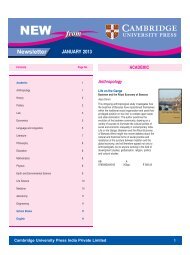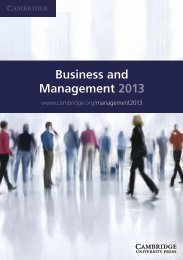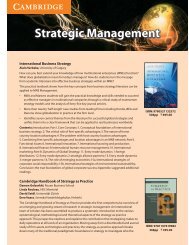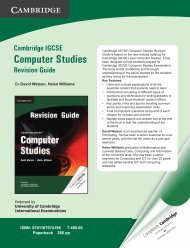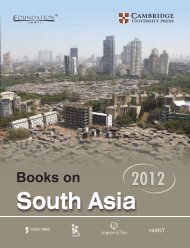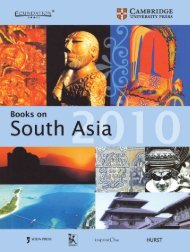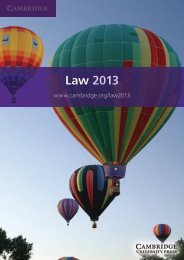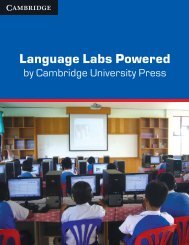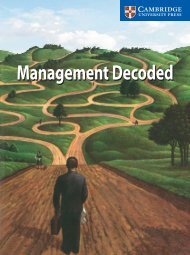India & Cambridge - Cambridge University Press India
India & Cambridge - Cambridge University Press India
India & Cambridge - Cambridge University Press India
- No tags were found...
You also want an ePaper? Increase the reach of your titles
YUMPU automatically turns print PDFs into web optimized ePapers that Google loves.
SOCIOLOGY & ANTHROPOLOGYSOCIOLOGY & ANTHROPOLOGY<strong>India</strong> Migration Report2010-2011: The AmericasBinod Khadria (ed)<strong>India</strong> Migration Report 2010–2011:The Americas discusses historicaland contemporary migrationbetween <strong>India</strong> and the Americancontinents. For more than half-acentury,<strong>India</strong> has been one of thelargest source countries ofmigrants to the US and Canada. Amajority of <strong>India</strong>n diaspora population in the US andCanada is highly educated and affluent. They holdimportant positions in the economic and socio-political setupof these two countries. In contrast, the <strong>India</strong>ns in SouthAmerica and the Caribbean are not so highly-skilled,educated or affluent. A significant proportion of them hadmigrated much earlier as low-skilled workers for plantationsin the colonies.This report is an attempt to examine <strong>India</strong>n migration to thetwo American continents following diverse trajectories.Besides providing an overview of migration from <strong>India</strong>, thereport also traces immigration of foreigners and returnmigration of <strong>India</strong>ns from the American continents to <strong>India</strong>.The focus of <strong>India</strong> Migration Report 2010–2011 is on puttingtogether available information on issues involving variousmigration patterns and analyzing the major factors andpolicies that shape them.The book will serve as an important reference source forgraduate students and researchers on migration generally,as well as being of obvious interest to specialists on theglobal <strong>India</strong>n diaspora.Binod Khadria, professor of Economics at the Zakir HusainCentre for Educational Studies, School of Social Sciences,Jawaharlal Nehru <strong>University</strong>, Delhi.9781107681033 166pp PB ` 995.00Wandering with Sadhus:Ascetics in the HinduHimalayasSondra L. HausnerIn this moving ethnographicportrait of Hindu renouncers –sadhus or ascetics – in northern<strong>India</strong> and Nepal, Sondra L. Hausnerconsiders a paradox that shapestheir lives: while ostensibly definedby their solitary spiritual practice,the stripping away of socialcommitments, and their break withfamily and community, renouncers in fact regularly interactwith each other and with “householder” society. They form adistinctive, alternative community with its own internalstructure, one that is not located in any single space. Highlymobile and dispersed across the subcontinent, its membersare regularly brought together through pilgrimage circuitson festival cycles. Drawing on many years of fieldwork,Hausner presents intimate portraits of individual sadhus asshe examines the shared views of space, time, and the bodythat create the ground of everyday experience. Written withan extraordinary blend of empathy, compassion, andanthropological insight, this study will appeal to scholars,students and general readers alike.Sondra L. Hausner is <strong>University</strong> Lecturer in the Study ofReligion at Oxford <strong>University</strong>.9788175968929 266pp PB ` 395.00The Emerging Dimensionsof SAARCS.D. Muni (ed)With the dawn of the twenty-firstcentury, South Asian region hasundergone radical transformation.It has witnessed a strongdemocratic sweep. Most of theSouth Asian economies haveregistered impressive growthtrajectories. Some of its countrieshave also emerged as the hub ofglobal terrorism. The internationalcommunity has become far more involved in South Asianaffairs due to the nuclearisation of the region. SAARCcannot but keep pace with the changing regional dynamics.It has moved ahead on its economic agenda and expandedits reach not only by adding new members (Afghanistan)but also by opening itself to the participation of many othercountries, including China, Iran and the US, as Observers.The Emerging Dimensions of SAARC is an attempt to look atthe changing dynamics of South Asia and to learn whetherSAARC will take regional cooperation and integration intheir various dimensions closer to reality. S.D.Muni, theeditor of this volume has compiled essays contributed byeminent academics and analysts, not only from most of theSAARC countries, but also from those joined as Observers.Besides looking at the trade and economic dimension ofSAARC, these essays discuss the security, political andcultural aspects of regional cooperation among the SouthAsian countries.S.D.Muni, a Visiting Research Professor at the Institute ofSouth Asian Studies, Singapore, taught for over thirty yearsat the Jawaharlal Nehru <strong>University</strong>, New Delhi.9788175967458 322pp HB ` 795.00The Court Chronicle of theKings of Manipur: TheCheitharon KumpapaVol. 2, 1764-1843 CESaroj Nalini Arambam ParrattThe Cheitharon Kumpapa is thecourt chronicle of the kings of thestate of Manipur, a small, formerlyindependent state situated on thenorth-eastern border of <strong>India</strong> withMyanmar. The Cheitharon Kumpaparecords events from the foundingof the ruling dynasty in 33 CE until the abolition of themonarchy and subsequent merger of the state with <strong>India</strong> in1949. The document is probably the oldest chronicle of theorder online at www.cambridgeindia.org37




